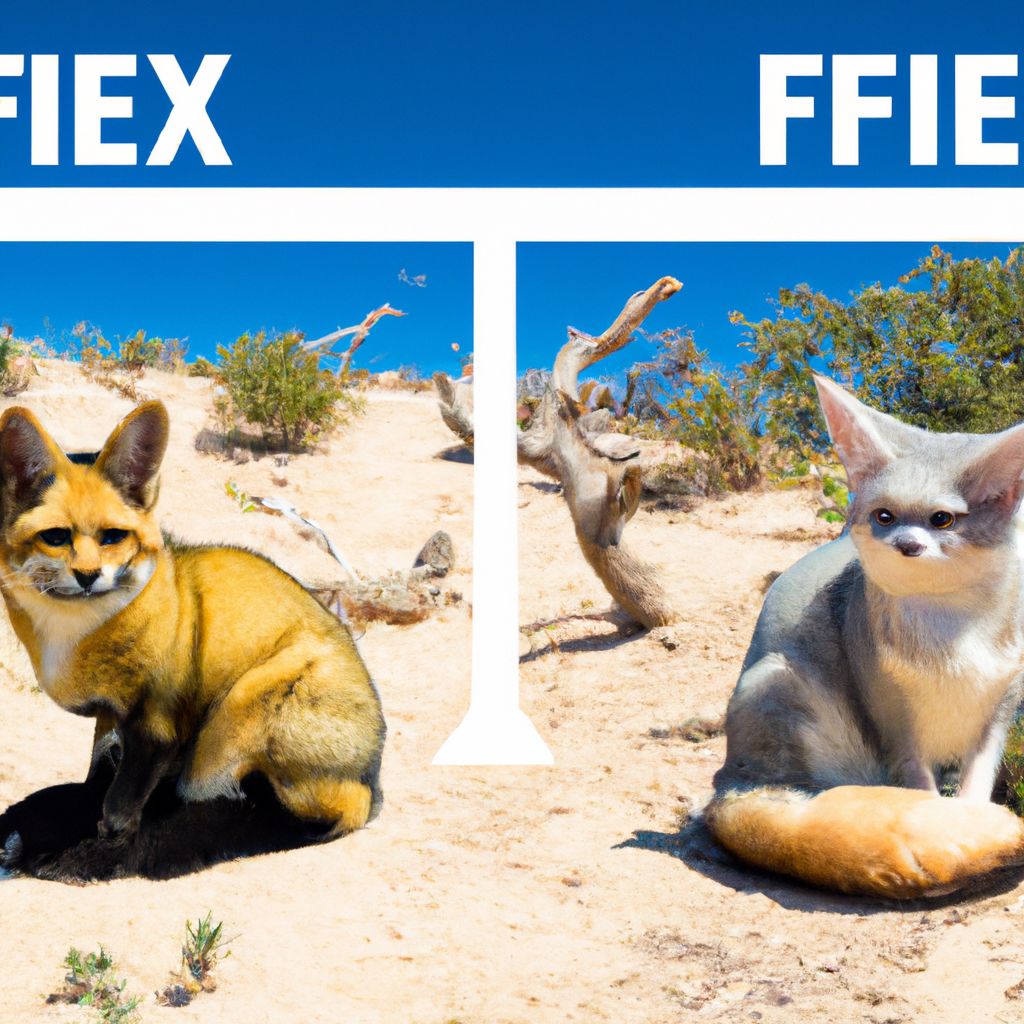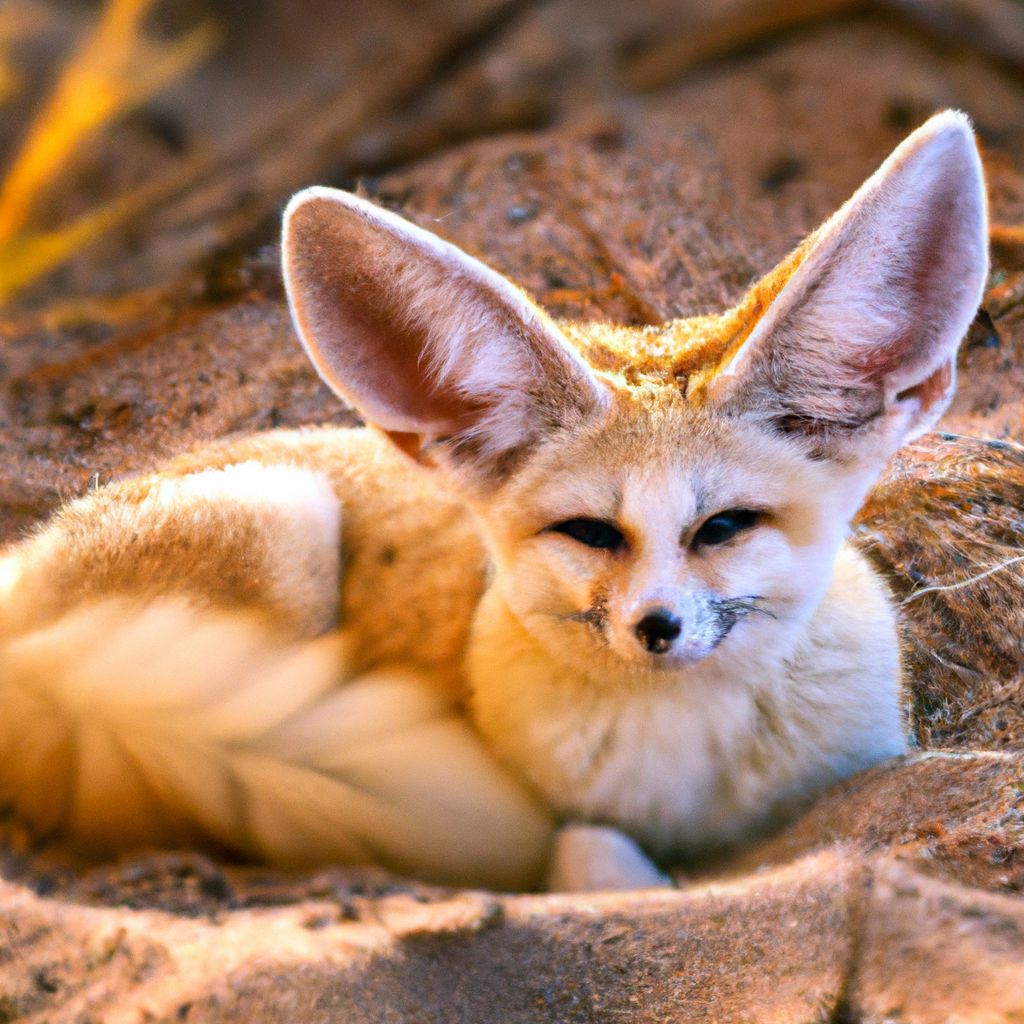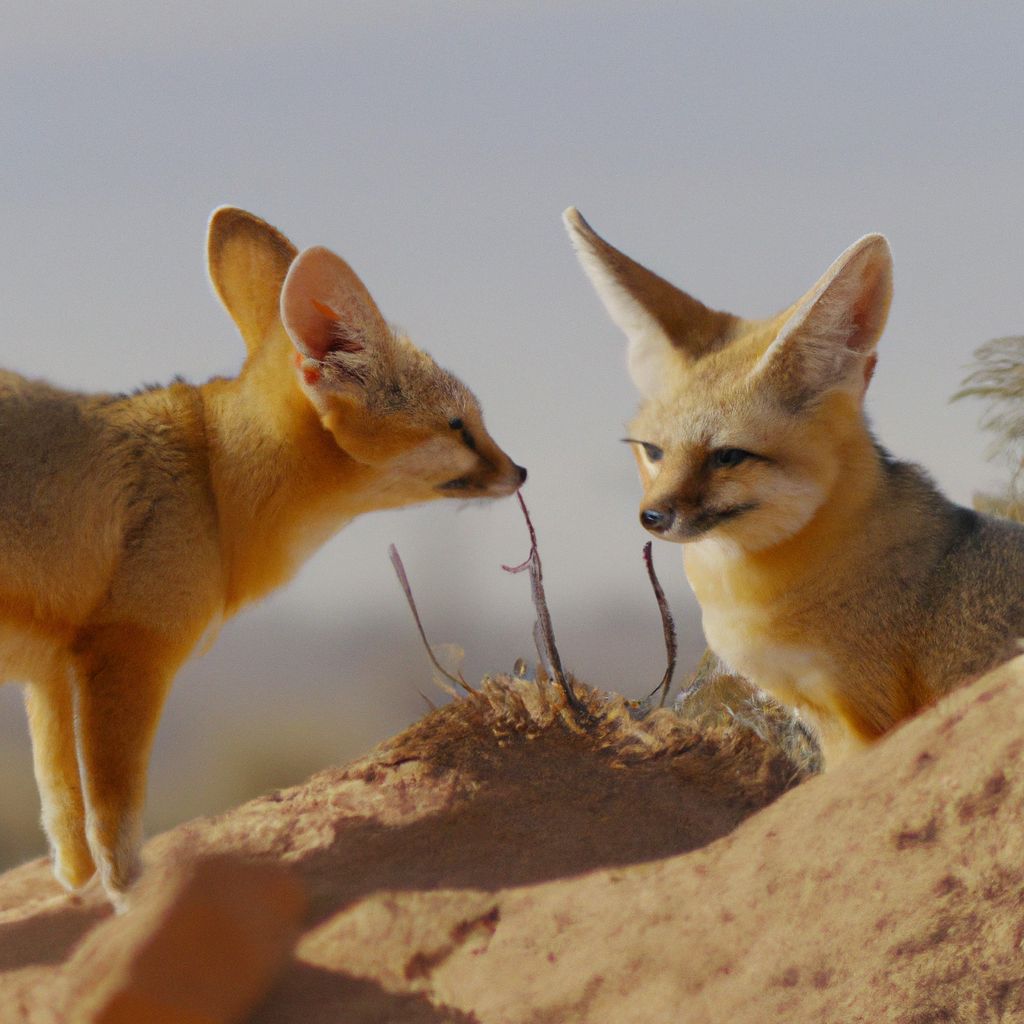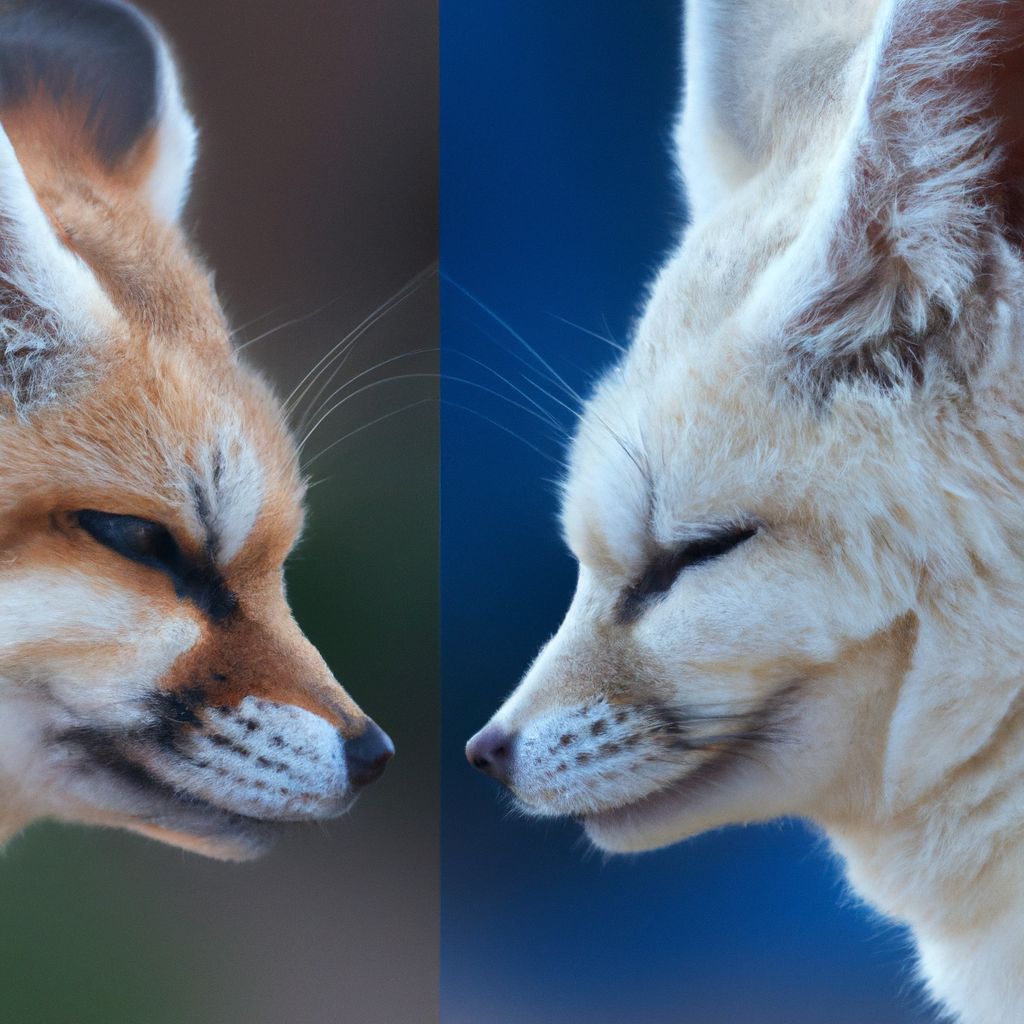The Cape Fox and Fennec Fox are two fascinating species of foxes that possess unique physical characteristics and exhibit distinct behaviors. Understanding the differences between these two species can provide valuable insights into their habitats, diet, and social behavior. Here is an introduction to the Cape Fox and Fennec Fox, followed by a discussion of their arctic fox diet.
The Cape Fox (Vulpes chama) and Fennec Fox (Vulpes zerda) are both members of the Canidae family, but they inhabit different regions and possess distinct features. The Cape Fox, also known as the Silver-backed Fox, is native to southern Africa. On the other hand, the Fennec Fox is found in the arid regions of North Africa and the Sahara Desert.
Starting with their physical characteristics, let’s examine the Cape Fox first. It typically has a size and weight that ranges from 45 to 61 centimeters and weighs around 3 to 5 kilograms. The fur of the Cape Fox is predominantly fawn-colored, with a characteristic silver-gray stripe along its back. It has relatively long, slender legs and a bushy, black-tipped tail. Their distinctly shaped face features a narrow muzzle and large, upright ears.
In contrast, the Fennec Fox is the smallest fox species, with a size and weight ranging from 24 to 41 centimeters and weighing approximately 0.68 to 1.5 kilograms. Their fur is pale yellow or cream in color, blending perfectly with the desert environment. The Fennec Fox is known for its oversized ears, which serve to dissipate heat and enhance hearing. These large ears also enable them to detect prey underground.
Next, we will explore the habitat and distribution of each fox species, as well as their diet and hunting behavior. We will also delve into their social behavior and draw a comprehensive comparison between the Cape Fox and the Fennec Fox, highlighting their differences in terms of size, habitat, adaptations, diet, hunting behavior, and social behavior. By gaining a deeper understanding of these marvelous creatures, we can appreciate their unique characteristics and contributions to their respective ecosystems.
Contents
- 1 Key takeaway:
- 2 Physical Characteristics of Cape Fox
- 3 Physical Characteristics of Fennec Fox
- 4 Habitat and Distribution of Cape Fox
- 5 Habitat and Distribution of Fennec Fox
- 6 Diet and Hunting Behavior of Cape Fox
- 7 Diet and Hunting Behavior of Fennec Fox
- 8 Social Behavior of Cape Fox
- 9 Social Behavior of Fennec Fox
- 10 Comparison of Cape Fox and Fennec Fox
- 11 Frequently Asked Questions
- 11.1 What are the evolutionary characteristics of Cape Fox and Fennec Fox?
- 11.2 What do Cape Foxes and Fennec Foxes eat in their natural habitats?
- 11.3 Where do Cape Foxes and Fennec Foxes prefer to live?
- 11.4 Are Cape Foxes and Fennec Foxes monogamous animals?
- 11.5 Do Cape Foxes and Fennec Foxes exhibit sexual dimorphism?
- 11.6 How do Cape Foxes and Fennec Foxes adapt to their respective habitats?
Key takeaway:
- Cape Fox and Fennec Fox are two different species of foxes with distinct physical characteristics.
- Cape Fox is larger and heavier than the Fennec Fox, with a size and weight advantage.
- Cape Fox has a reddish-brown fur color, while Fennec Fox has a pale sandy coloration.
- The facial features of Cape Fox include a bushy tail and large, pointed ears.
- Fennec Fox has oversized ears, which help regulate body temperature in their desert habitat.
- Cape Fox is found in various habitats across Africa, while the Fennec Fox is mainly found in the Sahara Desert.
- Both Cape Fox and Fennec Fox have a carnivorous diet and employ hunting behaviors.
- Cape Fox is solitary, while Fennec Fox is known to live in small family groups.
- Comparison between Cape Fox and Fennec Fox reveals differences in size, habitat, adaptations, diet, and social behavior.
- Fennec Fox has evolved adaptations to thrive in arid desert environments, such as large ears and the ability to obtain water from food.
Physical Characteristics of Cape Fox
With a closer look at the physical characteristics of Cape Fox, we will uncover fascinating details that set it apart from its counterpart, the Fennec Fox. From their size and weight to their unique fur color and texture, and even their distinguishing facial features, each sub-section will peel back the layers, revealing what makes the Cape Fox truly remarkable. So, let’s dive into the captivating world of Cape Fox and explore its exceptional physical attributes.
Size and Weight
The size and weight of the Cape Fox and Fennec Fox vary significantly. The Cape Fox has a length of approximately 45-61 cm, while the Fennec Fox is much smaller, measuring around 24-41 cm.
When it comes to weight, the Cape Fox is heavier, weighing about 2-3 kg, whereas the Fennec Fox is lighter, tipping the scales at only around 0.8-1.5 kg.
These differences in size and weight contribute to the distinct physical characteristics and adaptations of each fox species. The smaller size of the Fennec Fox enables it to thrive in desert environments, where it has adapted to extreme temperatures and arid conditions.
On the other hand, the larger and heavier Cape Fox may exhibit different hunting behaviors and social dynamics compared to the Fennec Fox. Their size and weight differences also influence their habitat preferences and adaptations.
By comprehending the variations in size and weight between the Cape Fox and Fennec Fox, we gain insights into their unique traits, behaviors, and ecological roles.
Fur Color and Texture
The fur color and texture of the Cape Fox and Fennec Fox are essential for their survival and adaptation to their environments. Here is a comparison of their fur color and texture:
| Cape Fox | Fennec Fox |
| The Cape Fox has short and dense fur. | The Fennec Fox has thick and soft fur. |
| The fur of the Cape Fox is sandy yellow to light gray. | The Fennec Fox has a pale yellowish to cream-colored fur. |
| The fur of the Cape Fox helps it blend in with arid and semi-desert habitats. | The light-colored fur of the Fennec Fox provides camouflage in the desert. |
| The fur texture of the Cape Fox helps regulate body temperature in extreme heat. | The thick fur of the Fennec Fox insulates its body in cold desert nights. |
These characteristics are adapted to their respective habitats, allowing these foxes to survive and thrive. The fur color and texture are essential for camouflage, protection, and temperature regulation.
Fun fact: The Fennec Fox’s large ears not only help them hear prey but also dissipate heat, keeping them cool in the desert environment.
Facial Features
The survival and communication of Cape Fox and Fennec Fox rely heavily on their facial features.
Cape Fox has a pointed snout that aids in digging burrows and searching for food. Its large, upright ears provide excellent hearing, allowing it to detect prey and potential threats. Additionally, Cape Fox has small, rounded eyes that give it keen eyesight to spot movements and predators.
On the other hand, Fennec Fox has a long, narrow snout that is essential for digging burrows and accessing food resources in the desert. Its most distinct feature is its oversized ears, which not only dissipate heat but also enhance its hearing capabilities. Moreover, Fennec Foxes have large, expressive eyes that aid in nocturnal vision and adapting to low light conditions.
Both Cape Fox and Fennec Fox rely on these facial features for survival. The snout and ears assist in foraging, while the eyes provide sensory perception and awareness.
While the facial features may not be the determining factor when choosing between these two fox species, understanding and appreciating these unique characteristics can deepen knowledge and admiration for these fascinating creatures.
Physical Characteristics of Fennec Fox
With its unique physical attributes, the Fennec Fox stands out among its peers. From its petite size and lightweight body to its captivating fur color and texture, and distinctive facial features, this section will take you on an exciting journey through the captivating physical characteristics of the Fennec Fox. Get ready to explore the fascinating world of this remarkable creature and uncover the facts that make it truly extraordinary.
Size and Weight
– The Cape Fox has an average size ranging from 45 to 61 centimeters in length and weighs between 3 to 5 kilograms. With its stocky build, it stands out among other foxes.
– On the other hand, the Fennec Fox is smaller, with an average size of 24 to 41 centimeters in length and a weight of 0.68 to 1.6 kilograms. Its body structure is slender and compact, making it a unique species.
– In terms of size and weight, male Cape Foxes are generally larger and heavier than their female counterparts.
– Similarly, male fennec foxes also exhibit larger size and heavier weight compared to females.
– One remarkable trait of Cape Foxes is their ability to adapt to various habitats and climates, showcasing their versatility.
– While Cape Foxes can thrive in different environments, Fennec Foxes are particularly well-suited for the desert environment, thanks to their physical adaptations.
Fur Color and Texture
Fur Color and Texture
Cape Fox:
– Fur Color: Cape Foxes have reddish or yellowish-brown fur, with a lighter underbelly. Some may have gray or silver coats.
– Fur Texture: Cape Foxes have short, dense, and coarse fur. It helps them withstand hot climates, providing protection from the sun and heat.
Fennec Fox:
– Fur Color: Fennec Foxes have pale yellowish or cream-colored fur, which helps them blend into sandy desert habitats. Their coat may also have reddish or grayish hues.
– Fur Texture: Fennec Foxes have very dense and soft fur, almost like a plush toy. This insulation helps them regulate their body temperature in extreme desert conditions.
It’s important to note that the fur color and texture can vary slightly among individuals and populations. These attributes aid in camouflage and temperature regulation, enabling the foxes to survive in their habitats.
Facial Features
The facial features of the Cape Fox and Fennec Fox are distinct and play a vital role in their survival and daily activities. Below is a comprehensive list of their unique facial features:
– Cape Fox:
- These foxes have large, triangular ears with a dark border and a white inner area. These ears are specifically designed to detect sounds and prey.
- They also have a prominent black nose which helps them detect scents and locate food.
- With small, almond-shaped eyes that have a vertical slit pupil, Cape Foxes have excellent vision and depth perception.
- Their dense and bushy eyebrows serve the purpose of protecting their eyes from sunlight and dust.
- In addition, they have whiskers around their muzzle which are highly sensitive and aid in object detection, especially in the dark.
\nIn terms of diet, the grey fox has a varied eating habit, exploring different food sources.
– Fennec Fox:
- Fennec Foxes are characterized by their enormous ears, which can reach up to 6 inches in length. These ears play a crucial role in thermoregulation and the detection of prey underground.
- They possess large, round eyes that have horizontally elongated pupils. This unique feature allows them to have a wider field of vision and better depth perception.
- With a small, slender, and elongated snout, Fennec Foxes are well-suited for digging burrows and capturing small prey.
- Their brightly colored, pinkish nose aids in scent detection and locating food.
- They have short and fine fur around their muzzle, which helps protect their face from extreme temperatures.
Both the Cape Fox and Fennec Fox have facial features that are uniquely adapted to their respective environments and lifestyles, highlighting the importance of these features in their survival and daily activities.
Habitat and Distribution of Cape Fox

Photo Credits: Foxauthority.Com by Christopher Lewis
Cape Fox, also known as the silver-backed fox or Vulpes chama, is endemic to southwestern Africa. Its habitat is primarily found in arid and semi-arid regions of Namibia, Botswana, and South Africa. Here are key factors regarding the habitat and distribution of Cape Fox:
1. Geographic range: The habitat and distribution of Cape Fox encompass desert plains, savannahs, and scrublands. They have adapted well to these arid environments.
2. Distribution: The distribution of Cape Fox populations is concentrated in Namibia, where they are commonly found throughout the country. They are also present in parts of Botswana, particularly in the central and southern regions. They have been observed in certain parts of South Africa.
3. Burrow dwellings: Cape Foxes create complex underground dens, which serve as their dwellings and provide shelter from extreme temperatures and predators.
4. Nocturnal behavior: Cape Foxes are primarily nocturnal and possess excellent night vision, which aids them in their hunting and foraging activities.
5. Diet: Cape Foxes have an omnivorous diet, consuming small mammals, insects, birds, eggs, fruits, and carrion. Their feeding habits are influenced by the availability of resources in their habitats.
Considering the specialized habitat and unique distribution of Cape Fox, it is crucial to prioritize conservation efforts that protect their native habitats and maintain ecosystem balance. Research and monitoring of Cape Fox populations can provide valuable insights into the health and sustainability of these arid regions. Understanding the habitat and distribution of Cape Fox allows for the implementation of effective strategies by researchers, conservationists, and policymakers to ensure the long-term survival of this species.
Habitat and Distribution of Fennec Fox

Photo Credits: Foxauthority.Com by Albert Clark
The Fennec fox is primarily found in the Sahara Desert and North Africa, which is its natural habitat and distribution area. It adapts well to various arid desert regions such as sandy deserts, rocky deserts, and semi-arid grasslands. Sandy deserts are particularly common habitats for this fox due to its ability to dig complex burrows for protection from the extreme heat during the day and cold nights. These burrows provide shelter not only for the fox but also for its family, ensuring their survival in the harsh desert environment.
One of the distinctive features of the Fennec fox is its large ears, which serve multiple functions. These ears help regulate the fox’s body temperature by dissipating heat and keeping it cool in the hot desert environment. The fox’s sandy-colored fur helps it blend seamlessly into its natural habitat, allowing it to camouflage itself and remain inconspicuous.
The Fennec fox can be found in several countries, including Algeria, Egypt, Libya, Mauritania, Morocco, and Sudan, as part of its distribution range. It has been introduced to the Arabian Peninsula and Israel. These regions provide suitable conditions for the fox’s survival and reproduction.
If you ever have the opportunity to observe a Fennec fox in its natural habitat, it is advisable to bring binoculars. The fox’s small size and excellent camouflage can make it challenging to spot without proper equipment. Nonetheless, the experience of witnessing this fascinating creature in its unique desert home will undoubtedly be unforgettable.
Diet and Hunting Behavior of Cape Fox

Photo Credits: Foxauthority.Com by Gary Lopez
The diet and hunting behavior of Cape foxes provide valuable insight into their survival in the wild.
- Diet: Cape foxes are omnivorous, consuming both plant and animal matter. They primarily eat small mammals like rodents, rabbits, and birds. They also eat insects, fruits, and berries when available. Cape foxes scavenge on carrion, making them opportunistic feeders.
- Hunting Behavior: Cape foxes primarily hunt at night, using their excellent hearing and sense of smell. They are agile and swift, able to catch small mammals with precision. Their hunting strategy involves stalking prey and launching a surprise attack. Cape foxes can dig burrows to access prey or create dens for shelter.
- Social Hunting: Cape foxes engage in cooperative hunting behaviors. They may form hunting pairs or small groups to increase their success rates. This social hunting behavior allows them to target larger prey or work together to capture elusive prey.
- Seasonal Variations: The diet and hunting behavior of Cape foxes may vary based on prey availability. During times of scarcity, they rely more on plant-based foods or carrion. They adjust their hunting strategies and diet according to the changing environment.
Understanding the diet and hunting behavior of Cape foxes provides valuable insight into their ecological role as predators and scavengers. It demonstrates their adaptability and resourcefulness in different environments, making them effective hunters.
Diet and Hunting Behavior of Fennec Fox
The diet and hunting behavior of the Fennec fox are absolutely captivating. Fennec foxes heavily rely on their sharp hearing to search for prey and are extremely adept at catching small animals such as rodents, birds, and insects. They are incredibly adaptable hunters and can alter their strategies based on the availability of food.
Fennec foxes possess an agile and swift hunting technique. They utilize their acute hearing to detect movement of prey beneath the ground and swiftly leap upon it. These foxes display great skill in digging, using their front paws to locate hidden prey. They possess razor-sharp teeth and claws to apprehend and secure their catch.
The Fennec fox is classified as an omnivorous species, consuming a combination of plant matter and meat. Their diet encompasses small mammals, birds, reptiles, fruits, and vegetation. They have the ability to adapt their diet to their arid environment, where food may be scarce. Fennec foxes are able to extract moisture from the food they consume, which aids in their survival in the desert where water is limited.
The diet and hunting behavior of the Fennec fox hold immense importance for their survival. Their remarkable skills and adaptability enable them to locate food and sustain their population. Gaining an understanding of their unique diet and hunting behavior provides valuable insights into their extraordinary adaptations.
Social Behavior of Cape Fox

Photo Credits: Foxauthority.Com by Gerald Lopez
The Cape Fox is known for its territorial behavior and social instincts. It establishes its territory, which measures an average of 3 to 5 square kilometers, by using scent markings, urine, and feces. These markings serve as a way for the fox to communicate ownership and deter potential intruders. They also provide a means of communication between individuals.
In terms of mating, Cape Foxes have a monogamous system and form long-term pair bonds with their mates. These pairs work together to defend their territory and raise their young. To strengthen their bond and maintain social cohesion, they engage in social grooming.
When it comes to raising their offspring, Cape Foxes exhibit cooperative care. Both parents share responsibilities such as protecting the den, hunting for food, and providing warmth and protection.
A remarkable example of Cape Fox social behavior can be seen in a situation where a pair of foxes successfully defended their territory against intruders. Through scent marking and territorial displays, the resident pair intimidated and drove away the intruders, thus ensuring the safety and stability of their social group.
This story serves as a testament to the Cape Fox’s strong territorial instincts and social behavior. It showcases their ability to cooperate, communicate, and overcome challenges in their natural habitat.
Social Behavior of Fennec Fox
The social behavior of fennec foxes is truly fascinating and unique. These desert-dwelling creatures form pair bonds, engage in mutual grooming, and exhibit cooperative behaviors. They are highly territorial, marking their territory with scent markings. Within their family groups, both male and female parents share the responsibilities of raising their offspring. In addition, fennec foxes engage in social interactions with other foxes in their community to establish hierarchies and boundaries.
The social behavior of fennec foxes can be influenced by factors such as habitat availability and resources. Limited resources can lead to more aggressive interactions among foxes due to competition for food and territory. To truly understand and appreciate their behavior, it is recommended to visit regions where they inhabit, such as the Sahara Desert and parts of North Africa. It is crucial to respect their natural habitats and observe them from a safe distance.
– Source 1
– Source 2
Comparison of Cape Fox and Fennec Fox

Photo Credits: Foxauthority.Com by Joshua Flores
When it comes to comparing the Cape Fox and the Fennec Fox, there’s a lot to discover. We’ll dive into the key aspects that set them apart, exploring their size and weight, habitat, adaptations, diet and hunting behavior, and social behavior. Get ready to uncover fascinating facts and gain a deeper understanding of these incredible creatures. So, let’s embark on this exciting journey into the world of foxes and see how they differ in various aspects of their lives!
Size and Weight
The size and weight of the Cape fox and the Fennec fox are noteworthy. The Cape fox surpasses the Fennec fox in terms of size, measuring 40-50 cm (15.7-19.7 inches) in length, while the Fennec fox is smaller, averaging 24-41 cm (9.4-16.1 inches) in length. In regards to weight, the Cape fox is heavier, ranging from 2.2-3.6 kg (4.9-7.9 lbs), whereas the Fennec fox is lighter, weighing between 0.68-1.6 kg (1.5-3.5 lbs).
These size and weight differences greatly impact the physical adaptations and behavior of each species. The larger size of the Cape fox enables it to adapt to a wider range of habitats, including grasslands and semi-deserts. On the other hand, the smaller size of the Fennec fox allows it to effortlessly navigate through narrow crevices and sandy environments.
Habitat
Habitat
When considering the habitat of the Cape Fox and Fennec Fox, there are key differences to note:
- The Cape Fox is found in southern regions of Africa, including South Africa, Namibia, and Botswana.
- The Fennec Fox is native to the sandy deserts of northern Africa, including the Sahara Desert, Morocco, Algeria, and Tunisia.
- The Cape Fox prefers diverse habitats such as grassland, savanna, and scrubland areas.
- The Fennec Fox thrives in hot and arid environments, making its home in sandy deserts with minimal vegetation.
- The Cape Fox is adaptable to different habitat types but avoids extremely dry or desert-like areas.
- The Fennec Fox has specialized abilities to withstand high temperatures and extreme conditions, making the desert its ideal habitat.
Fact: The Fennec Fox can survive in the desert due to its large ears, which help dissipate heat and control body temperature.
Adaptations
Edited
The Cape Fox and Fennec Fox have different adaptations, which are summarized in the table below:
| Adaptations | Cape Fox | Fennec Fox |
| 1. Ears | Cape Fox: Large ears for heat dissipation and improved auditory acuity. | Fennec Fox: Extremely large ears for heat dissipation, enhanced hearing, and locating prey underground. |
| 2. Fur | Cape Fox: Dense, coarse fur coat for insulation in cold temperatures. | Fennec Fox: Thick, insulated fur coat for withstanding extreme desert temperatures and camouflage. |
| 3. Night Vision | Cape Fox: Good night vision, but not as exceptional as the Fennec Fox. | Fennec Fox: Highly developed night vision for navigation and hunting in the dark desert. |
| 4. Body Size | Cape Fox: Larger size for competition with predators and capturing larger prey. | Fennec Fox: Small size for navigating narrow desert crevices and burrows. |
| 5. Water Conservation | Cape Fox: Adaptations for survival in arid regions with limited water sources, can derive water from food. | Fennec Fox: Specialized water conservation adaptations, including efficient kidneys and obtaining moisture from diet. |
These adaptations are crucial for the survival and success of both fox species. The Cape Fox is able to withstand cold temperatures, utilize large ears for hearing, and compete for larger prey. The Fennec Fox, on the other hand, excels in the desert with its exceptional night vision and adaptations for water conservation. These adaptations highlight the diversity and resilience of these remarkable fox species.
Diet and Hunting Behavior
The diet and hunting behavior of Cape Fox and Fennec Fox vary based on their natural habitats and adaptations. Here is a comparison:
| Species | Diet | Hunting Behavior |
|---|---|---|
| Cape Fox | Cape Fox mainly eats small mammals like rodents, hares, and birds. They also eat insects, reptiles, and fruits if available. | Cape Foxes primarily hunt at night using their sharp senses to locate prey. They are fast runners and rely on their hunting skills to catch small animals on the ground. |
| Fennec Fox | Fennec Foxes have an omnivorous diet. They eat small mammals, insects, birds, reptiles, eggs, fruits, roots, and plant matter. | Fennec Foxes are most active during dawn and dusk. They have excellent hearing that helps them locate prey underground. They dig burrows and use their long snouts to find insects and small mammals. They are known for their ability to locate desert rodents by sound. |
Both Cape Fox and Fennec Fox have adapted to their environments. Cape Fox catches ground-dwelling prey using agility and speed. Fennec Fox has specific adaptations for finding and capturing prey in the desert. Understanding these behaviors provides valuable insights into the ecological roles and survival strategies of these fascinating fox species.
Social Behavior
Cape Fox:
Cape foxes are known for their solitary nature. They establish and defend territories using scent and vocalizations, which are crucial for their social behavior. Although they are generally non-aggressive towards other cape foxes, they may become more territorial and assertive if resources are scarce.
Fennec Fox:
In contrast to cape foxes, fennec foxes are social animals that live in packs. These packs typically consist of a mated pair and their offspring. Fennec foxes exhibit cooperative behaviors such as grooming, playing, and hunting together, emphasizing their strong social bonds.
Both cape foxes and fennec foxes rely on scent and vocalizations to mark their territories and communicate with others. While cape foxes prefer to have their own territory, fennec foxes thrive within the support and protection of their pack, which enhances their social structure and increases their chances of survival, especially in their challenging desert habitat.
Pro-tip: When observing or interacting with these fascinating creatures, it is crucial to respect their territorial boundaries and understand their unique social behaviors. By avoiding any disturbances to their habitats, we can ensure their well-being and allow them to exhibit their natural behaviors freely.
Frequently Asked Questions
What are the evolutionary characteristics of Cape Fox and Fennec Fox?
The Cape Fox and Fennec Fox both exhibit primitive characteristics of the Vulpes group, which differentiate them from other fox species. These characteristics can be traced back to their evolutionary history within the Vulpes genus.
What do Cape Foxes and Fennec Foxes eat in their natural habitats?
Cape Foxes and Fennec Foxes are both omnivorous canids, meaning they have a varied diet. They feed on a range of prey, including smaller mammals, reptiles, insects, and fruits. Both fox species are opportunistic eaters and can adapt their diet based on availability.
Where do Cape Foxes and Fennec Foxes prefer to live?
Cape Foxes are primarily found in semi-arid regions, savannas, and grassy plains of southern Africa, while Fennec Foxes inhabit the sub-Saharan African desert, specifically in arid and semi-desert scrub habitats. Each species has adapted to its specific environment.
Are Cape Foxes and Fennec Foxes monogamous animals?
Yes, Cape Foxes and Fennec Foxes are both known to form monogamous pairs during their breeding season. They engage in long-term partnerships to raise their offspring together, sharing the responsibility of feeding and protecting their young.
Do Cape Foxes and Fennec Foxes exhibit sexual dimorphism?
Yes, Cape Foxes and Fennec Foxes display sexual dimorphism, with males typically being larger than females. In Cape Foxes, females are relatively smaller than males, while in Fennec Foxes, males are generally larger than females.
How do Cape Foxes and Fennec Foxes adapt to their respective habitats?
Cape Foxes have evolved to thrive in semi-arid regions and grassy plains, seeking refuge in burrows, holes, and dense thickets during the day. On the other hand, Fennec Foxes have adapted to the arid sub-Saharan African desert, where they utilize their large ears to dissipate heat and locate prey.


